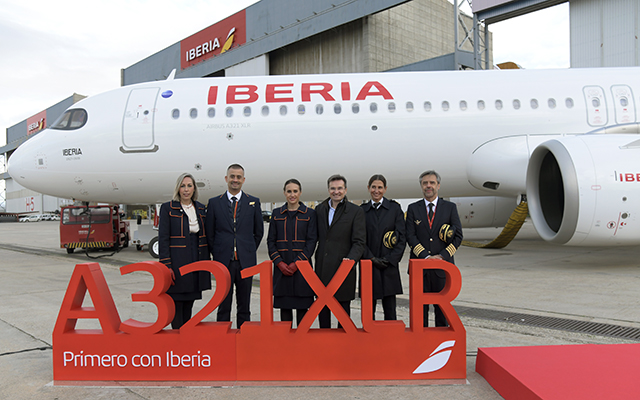


A New milestone in the history of the Spanish flag carrier Iberia is set to be recorded. The airline owned by the IAG group will operate tomorrow, on 14 November, the first transoceanic commercial flight with a narrow-body, single-aisle aircraft, the new Airbus A321-XLR, which was presented this Wednesday at its facilities in La Muñoza, Madrid.
With this step, Iberia, the IAG subsidiary, is ready to launch the new Airbus A321XLR aircraft worldwide, the single-aisle model designed to travel long distances, with a range of up to 7,500 kilometres, that's around 15% more than its predecessor, the A321LR.
Changing the rules of the norm for long-haul flights, Iberia's launch will challenge the wide body models with a large number of seats, those used to dominate these routes.
As explained today, 13 November. 2024, during its presentation by the president of Iberia, Marco Sansavini, the A321 XLR, thanks to its range of 7,500 kilometers, will also be able to cover these routes Trans-Oceanic routes.
He further added that, this advantage will allow the carrier to open routes such as Madrid-Washington all year round since having a smaller number of seats, 182, will not be necessary as it has been until now a great demand to fill a large plane and thus make a trip such as the one to the capital of the United States profitable.
Marco Sansavini, Iberia's Chairman, and Christian Scherer, Airbus CEO of Commercial Aircraft, highlight the positive impact the A321XLR will have on the airline's growth strategy, by providing a modern and sustainable travel experience.
Marco Sansavini expressed his pride in leading this industry advancement, stating,
“We are thrilled to be the first airline to launch the A321XLR on transatlantic routes. This new aircraft model allows us to reinforce our network and explore new destinations with efficiency and comfort for our customers.”
The A321XLR, known for its extended range due to an additional fuel tank (RCT), combines the efficiency of a narrow-body jet with the comfort and amenities typical of larger aircraft.
This fuel-efficient model boasts a 40% reduction in fuel consumption compared to wide-body alternatives, positioning it as one of the most eco-friendly choices for transatlantic travel. Iberia’s fleet will include a total of eight A321XLRs, enhancing the airline’s ability to expand its long-haul network and increase capacity on current routes.
For the Iberia's configuration, equipped with the latest Airspace cabin design, the A321XLR offers two classes, Business class with 14 individual seats convertible into a bed and direct access to the aisle, and Economy class, with 162 seats lighter than its predecessors.
Apart from the integrated central fuel tank mentioned above, the A321XLR’s innovative features also include structural and aerodynamic enhancements, advanced CFM LEAP-1A engines, which aids in extending the range to 4,000 nautical miles.
Iberia, which was selected by the IAG group ahead of AerLingus as the launch customer, believes, this aircraft sets a new standard for fuel efficiency and passenger comfort in long-haul travel, positioning Iberia at the forefront of sustainable aviation.
As Iberia’s latest addition to its long-haul fleet, the A321XLR aligns with the airline’s strategy to offer modern, comfortable, and environmentally conscious travel options. With plans to expand its transatlantic routes, Iberia is poised to set new benchmarks in both efficiency and customer experience.
Iberia's CEO, Marco Sansavini, stressed that, until now, only twin-aisle aircraft could cross the Atlantic, but A321XLR has come to change the paradigm.
The executive stressed that they will now be able to fly to more destinations and increase frequencies on routes where demand was not high enough to fill a twin-aisle aircraft, such as the Airbus A350s with which Iberia operates.
Airbus Commercial Aircraft CEO Christian Scherer highlighted the significance of this launch, noting,
“Seeing the A321XLR embark on its first transatlantic flight with Iberia is a landmark achievement. Routes like Madrid-Boston showcase the strategic value of the A321XLR in long-haul markets, providing unmatched passenger comfort in its Airspace cabin.”
There are eight such A321 variant units being acquired by Iberia, with the second aircraft of the fleet, that's currently at the Hamburg Finkenwerder (XFW/EDHI) FAL, is scheduled for early 2025 delivery.
The remaining six will be delivered between 2025 and early 2026. To this order, of which IAG has not made the investment public, another six are added for Aer Lingus, which will be the second world operator of the aircraft.
You may like to read....
